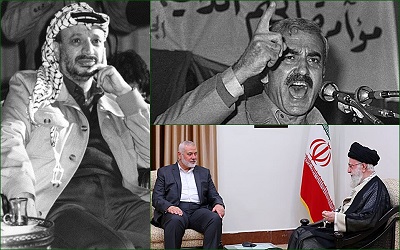New Delhi, (Asian independent) Under its military fatigue and white-and-black checked keffiyeh-clad leader, the Palestine Liberation Organisation (PLO) was once synonymous with the Palestinian cause but has been increasingly sidelined as the more radical Islamist Hamas, the Palestinian Islamic Jihad, and even the non-Palestinian Hezbollah took over the mantle of the fight for the people.
The reasons for this state of affairs are multi-fold — ranging with the PLO — and now as the Palestinian Authority’s lack of success in its mission since the process for a negotiated solution began, Israeli intransigence, provocations, and backsliding, changing regional dynamics, work for the people, and so on.
But before coming to these reasons in more detail, it must be realised that what Yasser Arafat aka Abu Ammar — and now Mahmoud Abbas aka Abu Mazen — actually led was the Fatah, the largest — and most dominant — constituent of the PLO, which spans a remarkable gamut of political stances and opinion.
The PLO, which according to its mission to the UN, is “a broad national front, or an umbrella organisation, comprised numerous organisations of the resistance movement, political parties, popular organisations, and independent personalities and figures from all sectors of life” who are “committed to the struggle for Palestinian independence and liberation”.
And hence, its constituents still comprise a remarkable range of parties, ranging from centrist to radical left and some still following an ideology that has disappeared from Arab countries where it was once predominant.
The kernel of the organisation, however, is the secular, nationalist, left of centre Fatah.
Derived from a reverse acronym of the Ḥarakat al-Taḥrir al-Watani l-Filastini (the Palestine National Liberation Movement), Fatah was formed in 1959 by Cairo or Beirut-educated Palestinian refugees in Gulf states, including Arafat.
It joined the PLO which came up in 1964 as Arab states, led by Gamal Abdel Nasser’s Egypt, sought to transfer prime responsibility of the Palestinian struggle to the displaced Palestinians themselves.
Palestinian lawyer and politician Ahmad al-Shukeiri, whose eventful career included serving as a member of the Syrian delegation to the UN and then Saudi Ambassador to the UN, was the PLO’s first Chairman, serving from its inception till late 1967, when he stepped down in the wake of the Arab-Israeli war debacle.
He was succeeded by Yahya Hamoudeh, who held the post for just over an year before Arafat took over in February 1969 and held it until his death – besieged by Israeli forces – in his West Bank home in 2004.
It was, thus, Arafat, and after him, Abbas, who came to be seen as the PLO itself.
The PLO presently comprises 10-odd parties.
After Fatah, the second large constituent is the revolutionary Marxist-Leninist Popular Front for the Liberation of Palestine, founded in 1967 by Palestinian Christian physician George Habash and noted for its spate of hijacking of airliners in the 1970s, and its splinter group, the equally communist Democratic Front for the Liberation of Palestine formed in 1968.
Then, there is the left-wing Palestinian Liberation Front-Abu Abbas faction, which broke away from the Popular Front for the Liberation of Palestine-General Command, the Arab Liberation Front, which was aligned to the Iraq’s Ba’ath Party, As-Sa’iqa, a Syrian-controlled Ba’athist faction, the democratic socialist, non-militant Palestinian Democratic Union-Fida, the socialist Palestinian Popular Struggle Front-Samir Ghawsha faction, and the pro-Fatah Palestinian Arab Front, also once influenced by Iraqi Ba’athists.
However, Hamas and the Palestinian Islamic Jihad – which have come to the forefront of the present Palestinian struggle – are not its members. Hamas, at least, owes part of its rise to overt and covert support from the Israeli government under a bid to create a counterweight to the PLO.
Paradoxically, the PLO’s ceding space came at the time of what should have its most significant moment – the path-breaking Oslo Accord I signed in the White House lawns in 1993, marking recognition between Israel and the PLO and laying the groundwork for eventual peace by Palestinian self-rule and statehood. Oslo II followed in 1995.
However, the possibilities for peace from the Oslo Accords were never realised as Israel never seemed to accept returning to its pre-1967 borders in relation to the West Bank and Jerusalem or countenance the existence of a truly independent Palestinian state.
After the failure of the Camp David Summit in 2000, any forward movement was virtually absent in the new century – especially after 9/11.
Whatever limited gains the new Palestinian Authority made were overshadowed by the heavy hand of Israel, which intervened with force at will, the increasingly right-wing swing in the country, and the continuing spread of Israeli settlements in the West Bank.
Meanwhile, corruption in the Authority, lack of development, and democracy also contributed to the PLO-led Palestinian Authority’s decline. The last elections were held in 2006 and Hamas won – and all know how that turned out!
Hamas seized power in the Gaza Strip – driving out the Fatah, and the Israelis, who had fully withdrawn from the area under Ariel Sharon in 2005, and imposed a tight blockade there from 2007.
Despite that, Hamas, aided by support from some Arab nations and Turkey as well as the UN, sought to administer Gaza as best it could, cracking down on the rampant criminality and providing social services, like health, education, and sanitation services in the densely-populated enclave.
With only Hamas and Islamic Jihad keeping up the fight against Israel, the PLO could not keep pace, even with Fatah having a military arm – the Al-Aqsa Martyrs’ Brigades, though its command and structure is quite splintered and impact not very significant.
Unable to proceed diplomatically and politically, the PLO was bound to lose relevance and support to more energetic – and radical – contenders.
The consequences for the region can be well imagined.








